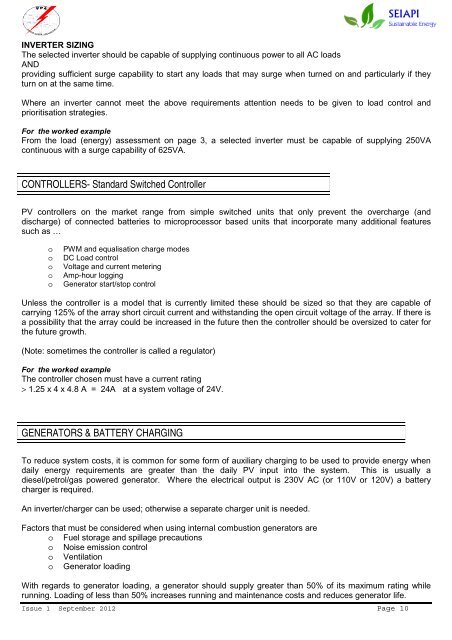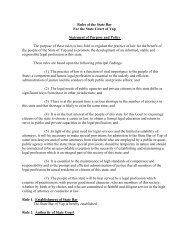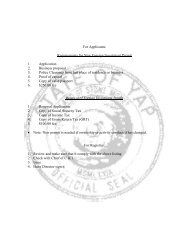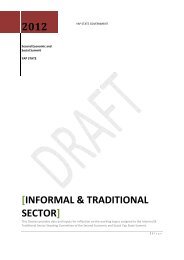CORRIGENDUM No. 2 - Yap State Government
CORRIGENDUM No. 2 - Yap State Government
CORRIGENDUM No. 2 - Yap State Government
Create successful ePaper yourself
Turn your PDF publications into a flip-book with our unique Google optimized e-Paper software.
INVERTER SIZING<br />
The selected inverter should be capable of supplying continuous power to all AC loads<br />
AND<br />
providing sufficient surge capability to start any loads that may surge when turned on and particularly if they<br />
turn on at the same time.<br />
Where an inverter cannot meet the above requirements attention needs to be given to load control and<br />
prioritisation strategies.<br />
For the worked example<br />
From the load (energy) assessment on page 3, a selected inverter must be capable of supplying 250VA<br />
continuous with a surge capability of 625VA.<br />
CONTROLLERS- Standard Switched Controller<br />
PV controllers on the market range from simple switched units that only prevent the overcharge (and<br />
discharge) of connected batteries to microprocessor based units that incorporate many additional features<br />
such as …<br />
o<br />
o<br />
o<br />
o<br />
o<br />
PWM and equalisation charge modes<br />
DC Load control<br />
Voltage and current metering<br />
Amp-hour logging<br />
Generator start/stop control<br />
Unless the controller is a model that is currently limited these should be sized so that they are capable of<br />
carrying 125% of the array short circuit current and withstanding the open circuit voltage of the array. If there is<br />
a possibility that the array could be increased in the future then the controller should be oversized to cater for<br />
the future growth.<br />
(<strong>No</strong>te: sometimes the controller is called a regulator)<br />
For the worked example<br />
The controller chosen must have a current rating<br />
> 1.25 x 4 x 4.8 A = 24A at a system voltage of 24V.<br />
GENERATORS & BATTERY CHARGING<br />
To reduce system costs, it is common for some form of auxiliary charging to be used to provide energy when<br />
daily energy requirements are greater than the daily PV input into the system. This is usually a<br />
diesel/petrol/gas powered generator. Where the electrical output is 230V AC (or 110V or 120V) a battery<br />
charger is required.<br />
An inverter/charger can be used; otherwise a separate charger unit is needed.<br />
Factors that must be considered when using internal combustion generators are<br />
o Fuel storage and spillage precautions<br />
o <strong>No</strong>ise emission control<br />
o Ventilation<br />
o Generator loading<br />
With regards to generator loading, a generator should supply greater than 50% of its maximum rating while<br />
running. Loading of less than 50% increases running and maintenance costs and reduces generator life.<br />
Issue 1 September 2012 Page 10
















